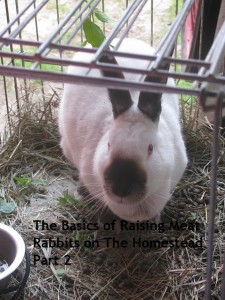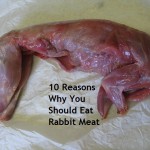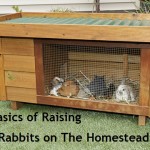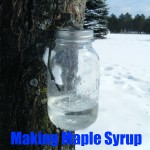The Basics of Raising Meat Rabbits on the Homestead: Part 2
(Mike’s note: Today brings the second and final installment of Rick from Rise and Shine Rabbitry’s guest blog. Check out his blog and his Facebook page.)
Feeding Rabbits
 Feeding rabbits is probably the most important part of raising rabbits, also the most argued. It is what controls the health and condition of the rabbit (even good genetics in rabbits cannot override a poor feeding program). Most people who begin with rabbits overfeed their herd. Feeding once a day is enough only pregnant does and growing kits need extra feed. Always feed on a regular schedule-a rabbit becomes accustom to a set feeding schedule and will become agitated and restless when the schedule is not kept. A constant supply of water is a must and should be changed daily. In the winter try to change frozen crocks as much as possible, at least two times a day, once in the morning and again in the evening. When you get your rabbits be sure to ask what feed they are using try to get some of the same brand from a feed store or buy some from the breeder. If you plan to change brands make sure to mix some of the new feed with the old brand for a couple weeks before switching over to the new feed completely. Any change of diet to rabbits should be done slowly! Rabbit pellets are usually dark green in color and has the nutritional requirements to produce a healthy rabbit and excellent growth in young. Check the labels and feed as manufacturer recommends. Pellets are easy to feed and requires less labor than natural feeding or pasture management . Pellets have changed a lot in my time raising rabbits and not for the better. More corn and soy and less alfalfa based feeds are sold, most all products are waste products from mills, most are GMO grown and round up sprayed, so read your feed labels and choose your feed for your rabbits informed. There are still some good rabbit food companies out there! Grass hay is one of the most important item in the rabbit diet, it should be fed in unlimited quantities. A rabbit fed only commercial rabbit pellets dose not get enough long fibers to keep the intestines in good working order, the long fibers of hay push things thru the gut at the right speed. Hay is also good for preventing intestinal impaction caused by ingested hair. Alfalfa or clover hays should be fed restricted as they are to rich in protein and calcium to be free fed. Fresh vegetables help keep the intestinal contents hydrated,which make them easier for the rabbit to pass. Rabbits love fresh,fragrant herbs right from the garden. If your rabbit shows any signs of stomach problems,such as runny stool take away the pellets and veggies and feed only grass hay or even straw until stools harden up. Green feeds are the natural food of rabbits. These are rich in protein minerals and vitamins,being soft and tender they are easily digested. They should be included in your feeding program. Rabbits can be fed lots of types of greens including lawn clippings,cabbage,kale,safe weeds(do your homework lots of good weeds for rabbits out there),waste from your vegetables from the garden,prunings from fruit trees,sweet potato vines and lots more. Any green feed not eaten should be removed from the hutch daily. Roots may be grown and used fresh or saved for feeding in the winter months such as carrots,sweet potatoes,mangles,rutabagas,turnips and beets. This is just the basics of feeding rabbits, I would love to do more on this subject and if there is interest I will!
Feeding rabbits is probably the most important part of raising rabbits, also the most argued. It is what controls the health and condition of the rabbit (even good genetics in rabbits cannot override a poor feeding program). Most people who begin with rabbits overfeed their herd. Feeding once a day is enough only pregnant does and growing kits need extra feed. Always feed on a regular schedule-a rabbit becomes accustom to a set feeding schedule and will become agitated and restless when the schedule is not kept. A constant supply of water is a must and should be changed daily. In the winter try to change frozen crocks as much as possible, at least two times a day, once in the morning and again in the evening. When you get your rabbits be sure to ask what feed they are using try to get some of the same brand from a feed store or buy some from the breeder. If you plan to change brands make sure to mix some of the new feed with the old brand for a couple weeks before switching over to the new feed completely. Any change of diet to rabbits should be done slowly! Rabbit pellets are usually dark green in color and has the nutritional requirements to produce a healthy rabbit and excellent growth in young. Check the labels and feed as manufacturer recommends. Pellets are easy to feed and requires less labor than natural feeding or pasture management . Pellets have changed a lot in my time raising rabbits and not for the better. More corn and soy and less alfalfa based feeds are sold, most all products are waste products from mills, most are GMO grown and round up sprayed, so read your feed labels and choose your feed for your rabbits informed. There are still some good rabbit food companies out there! Grass hay is one of the most important item in the rabbit diet, it should be fed in unlimited quantities. A rabbit fed only commercial rabbit pellets dose not get enough long fibers to keep the intestines in good working order, the long fibers of hay push things thru the gut at the right speed. Hay is also good for preventing intestinal impaction caused by ingested hair. Alfalfa or clover hays should be fed restricted as they are to rich in protein and calcium to be free fed. Fresh vegetables help keep the intestinal contents hydrated,which make them easier for the rabbit to pass. Rabbits love fresh,fragrant herbs right from the garden. If your rabbit shows any signs of stomach problems,such as runny stool take away the pellets and veggies and feed only grass hay or even straw until stools harden up. Green feeds are the natural food of rabbits. These are rich in protein minerals and vitamins,being soft and tender they are easily digested. They should be included in your feeding program. Rabbits can be fed lots of types of greens including lawn clippings,cabbage,kale,safe weeds(do your homework lots of good weeds for rabbits out there),waste from your vegetables from the garden,prunings from fruit trees,sweet potato vines and lots more. Any green feed not eaten should be removed from the hutch daily. Roots may be grown and used fresh or saved for feeding in the winter months such as carrots,sweet potatoes,mangles,rutabagas,turnips and beets. This is just the basics of feeding rabbits, I would love to do more on this subject and if there is interest I will!
Breeding Rabbits
Rabbits of medium size (most meat breeds)are ready to breed when they reach the age of 5 to 8 months of age-some breeders go by weight not by the age of the rabbit. Many young bucks will attempt to breed as early as 3 months it is best to separate them at this age,you do not want does that young to get pregnant the young will be small and there will be few kits in the litter,it also stunts the growth rate of the doe itself. Just as important do not wait to long to breed your does or the first time they will be hard to breed. While doing your chores in the rabbitry if you notice a doe trying to nose and scratch her way into other cages-or rubbing her chin on things like feeders,and crocks she’s ready to breed. When looking at the does sexual organ if her vulva is moist and bright pink to a reddish color all the way to the tip,she is ready to breed. As the cycle is waning the vaginal opening becomes a bright purple. Rabbits are induced ovulators,meaning ovulation does not occur until the actual mating by the buck. Always take the doe to the bucks cage. Does are very territorial about their cages and will attack the visiting buck and can cause serious harm to the buck. A ratio of one buck for every 10 does is necessary,the buck may be bred up to 7 times a week effectively. The doe usually accepts (lifts her tail and raises her back end) the buck will mount her vibrate and then he will fall over to the side or even backwards, some bucks are very dramatic! Within a minute he will be right back up to repeat the mating. I usually return the doe to the bucks cage for a re breeding 6 to 12 hours after the first mating. This improves conception rate and increases the number of kits in a litter. Keep accurate records of the day you bred the doe! You should test her for pregnancy between the 10th and 14th day after breeding. The best way is to palpate by checking the lower abdomen of the doe with your thumb and forefinger checking for nodules about the size of a marble. The other way is to take her back to the bucks cage and if she runs around growling and trying to avoid the buck she is most likely pregnant. This method is inaccurate as some does will breed again and will already be pregnant or refuse to and will not be pregnant. The gestation period is the time from mating to kindling and is 31 to 32. The nest box should be put in the does cage on day 27 from when the doe was bred(remember those accurate records a good litter of kits on the wire and you will not be happy). Fill the nest box 1/2 to 3/4 full with nesting material such as straw (my favorite),hay, shavings, dry leaves ect. I also put some nesting material in the cage so the doe can pick up some to add to her nest box. The doe will make her nest and by the time she kindles will be pulling fur. Watch expectant does often especially if they are first time mothers, if she has her kits on the wire you can put them in the nest box as long as they have not been chilled, if they have been chilled they should be warmed immediately and put back into the box and covered with fur. If the doe has more than 8 kits you should foster them to a doe with a smaller litter, unless you know the doe to be a good producer of milk (A doe only has 8 teats so only so many kits can eat at once). After the doe has kindled and seems to be mellowed out it is time to check the nest box,give the doe a treat (i usually give a small piece of apple or banana) and while she is enjoying her well deserved treat check the litter, remove any dead or stunted young and put the nest box back in the cage. 8 good healthy kits have a better chance and will grow faster than a litter of 12 to 14 weak kits. It is best to check the nest boxes every day the first week and every other day after that. By checking on the kits you will see if they are eating buy their plumpness and full tummies. A doe only nurses her young one or twice a day for only 2-5 minutes.If the doe is not feeding them, place the doe in the nest box and hold her until the kits start to nurse. The kits are born naked and blind they will grow very fast,in about 2 weeks their eyes will open and in 3 weeks will start to leave the nest box. You can wean the kits from 4 weeks at the earliest and at the latest 8 weeks depending or your breeding cycle. It is important to keep the doe and kits on full feed and plenty of fresh water to keep them all healthy. The young rabbits should weigh 4+ pounds at 8 weeks of age now it is time to slaughter and select the fastest growers for your replacement breeding stock, or to move them to grow out cages.
This has only been a basic of raising rabbits. I plan on doing a few more of this series the next will be on slaughtering-selling-and using everything from your rabbits plus answering any questions anyone has .Thanks for reading!
Photo Credit: edenpictures
Affiliate Disclosure: I am grateful to be of service and bring you content free of charge. In order to do this, please note that when you click links and purchase items, in most (not all) cases I will receive a referral commission. Your support in purchasing through these links enables me to keep the content train rolling





Follow Us!